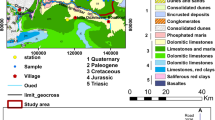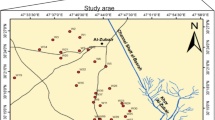Abstract
Unplanned abstraction of groundwater due to various land use land cover activities and variations in monsoonal rainfall have greatly affected the availability and quality of groundwater resources in semi-arid regions of India. In the present study, a study of the hydrogeochemical characteristics of groundwater was undertaken in the Sonipat district of Haryana in India together with the use of stable isotope (δ18O and δD) measurements and GIS analysis. A total of 53 groundwater samples were collected from seven blocks of the district, and 14 water quality parameters and stable isotopes (δ18O and δD) were analysed to infer hydrogeochemical processes taking place in the area. The integration of hydrochemistry with GIS is very helpful to understand the factors governing in the area. The majority of the samples showed Na–Cl type of hydrochemical facies. The trilinear plot for major cations and anions in groundwater indicates dominance of sodium, calcium, chloride and bicarbonate ions. Nitrate plumes in the groundwater appear to be migrating in groundwater from the central and south-western parts of the area towards the urbanized areas. A total of 64% of the samples exceed the maximum permissible limit of 1.5 mg/L given by WHO for fluoride. Besides natural sources such as silicate and carbonate weathering, ion exchange, and reverse ion exchange, the leaching of surficial salts and untreated industrial wastes along with unregulated abstraction are contributing to poor groundwater quality in the study area. An assessment of saturation indices has shown that groundwater in the area is unsaturated with respect to anhydrite, halite and gypsum suggesting significant contribution of Ca2+, Mg2+ and other ions in the groundwater. A scatter plot of δ18O versus Cl also suggests mixing of saline water with fresh groundwater.








Similar content being viewed by others
References
American Public Health Association (APHA) (2012) Standard methods for the examination of water and waste water, 22nd edn. Washington, p 1360. ISBN 978-087553-013-0
BIS (2009) Drinking water specifications. Bureau of Indian Standard, IS: 10500
Burrough PA, McDonnell RA (1998) Principles of geographical information systems for land resources assessment. Oxford University Press, New York
CGWB (2007) Groundwater year book. Ministry of Water Resources, Govt. of India
CGWB (2008) Ground water information booklet of Sonipat district, Haryana, Central Ground Water Board, Government of India, North western region, Chandigarh
CGWB (2013) Ground water information booklet of Sonipat district, Haryana, Central Ground Water Board, Government of India, North western region, Chandigarh
Choudhary BS, Kumar M, Roy AK, Ruhal DS (1996) Application of remote sensing and Geographic Information System in ground water investigations in Sohna block, Gurgaon district, Haryana (India). Int Arch Photogram Rem Sens XXXI(B6):21
CII (2010) Confederation of Indian Industry—Northern Region, Haryana annual report 2010–2011. http://www.cii.in
Das BK, Kakar YP, Moser H, Stichler W (1988) Deuterium and oxygen-18 studies in groundwater of the Delhi area, India. J Hydrol 98:133–146
Datta KK, de Jong C (2002) Adverse effect of water logging and soil salinity on crop and land production in northwest region of Haryana, India. Agric Water Manag 57:223–238
Datta PS, Tyagi SK. (2004) Evidences of climatic uncertainties linked groundwater variability in peri-urban agricultural areas of Delhi. In: Proceedings of the 1st Asia Oceania geosciences society (AOGS) conference, 5–8 Jul 2004, Singapore
Datta PS, Bhattacharya SK, Tyagi SK (1996) 18O studies on recharge of phreatic aquifers and groundwater flow-paths of mixing in the Delhi area. J Hydrol 176:25–36
Datta PS, Deb DL, Tyagi SK (1997) Assessment of groundwater contamination from fertilizers in the Delhi area based on δ180, NO3 and K+ composition. J Contam Hydrol 27:249–262
Freeze RA, Cherry JA (1979) Groundwater. Prentice-Hall, Englewood Cliffs, p 604
Garg VK, Suthar S, Singh S, Sheoran A, Garima M, Jain S (2008) Drinking water quality in villages of southwestern Haryana, India: assessing human health risks associated with hydrochemistry. Environ Geol. doi:10.1007/s00254-008-1636-y
Garrels RM, Mackenzie FT (1971) Evolution of sedimentary rocks. W. W. Norton and Company, Inc., New York, p 397
Goel PD, Datta PS, Tanwar BS (1977) Measurement of vertical recharge to groundwater in Haryana State (India) using tritium tracer. Nord Hydrol 8:211–224
Gupta SK, Deshpande RD (2005) Groundwater isotopic investigations in India: What has been learned? Curr Sci 89(5):825–835
Haritash AK, Kaushik CP, Kaushik A, Kansal A, Yadav AK (2008) Suitability assessment of groundwater for drinking, irrigation and industrial use in some North Indian villages. Environ Monit Assess 145(1–3):397–406. doi:10.1007/s10661-007-0048-x
Haryana Development Report (2009) Planning commission government of India New Delhi, ISBN 13: 9788171887132
Jadhao RB (2013) Ground water resource assessment: a case study on Murthal Block of Sonipat district. J Appl Chem, pp 16–23, ISSN: 2278-5736
Kamra SK, Lal K, Singh OP, Boonstra J (2002) Effect of pumping on temporal changes in groundwater quality. Agric Water Manag 56:169–178
Katz BG, Hornsby HD (1998) A preliminary assessment of sources of nitrate in spring waters, Suwannee River Basin, Florida. US Geol Sur 18:98–99
Kaushik A, Kumar K, Sharma IS, Sharma HR (2002) Groundwater quality assessment in different landuse areas of Rohtak and Fridabad cities of Haryana using deviation index. J Environ Biol 25:173–180
Kaushik A, Kumar K, Sharma IS, Sharma HR (2004) Groundwater quality assessment in different land-use areas of Faridabad and Rohtak cities of Haryana using deviation index. J Environ Biol 25(2):173–180
Khaiwal R, Garg VK (2007) Hydro-chemical survey of groundwater of Hisar city and assessment of defluoridation methods used in India. Environ Monit Assess 132(1–3):33–43
Lorenzen G, Sprenger C, Baudron P, Gupta D, Pekdeger A (2012) Origin and dynamics of groundwater salinity in the alluvial plains of western Delhi and adjacent territories of Haryana State, India. Hydrol Process 26(15):2333–2345
Malik J (2012) Changing landuse pattern in Haryana. Int J Comp Corpor Res. ISSN: 2249 - 054X
Maya AL, Loucks MD (1995) Solute and isotopic geochemistry and groundwater flow in the Central Wasatch Range. Utah J Hydrol 172:31–59
Meenakshi, Garg VK, Kavita, Renuka, Malik A (2004) Groundwater quality in some villages of Haryana, India: focus on fluoride and fluorosis. J Hazard Mater 106B:85–97
Mor S, Bishnoi M, Bishnoi NR (2003) Assessment of groundwater quality of Jind city. Ind J Environ Port 23:673–679
NCR (2011–2012) Annual report on national capital region planning board, ministry of urban development, government of India
Parkhurst DL, Appelo CAJ (1999) User’s guide to PHREEQC (ver. 2) a computer program for speciation, batch-reaction, one dimensional transport, and inverse geochemical calculations. US Geological Survey. Water-Resources Investigation Report (99-4259)
Piper AM (1944) A graphic procedure in geochemical interpretation of water analyses. Trans Am Geophys Union 25:914–923
Poonam, Rajesh K, Ashok Y (2013) Ground water quality in Mohendergarh Town, Haryana (India). Int J Pharma Chem Sci 2:226–228
Pradhan S, Chadrasekharan H, Jain N, Yadav BR (2011) Characterization of groundwater quality for irrigation in ‘Gohana’ block of Sonepat district, Haryana. J Agr Phys 11:63–70
Rajmohan N, Elango L (2004) Identification and evolution of hydrogeochemical processes in the groundwater environment in an area of the Palar and Cheyyar River Basins, Southern India. Environ Geol 46:47–61
Rina K, Datta PS, Singh CK, Mukherjee S (2012) Characterization and evaluation of processes governing the groundwater quality in parts of the Sabarmati Basin, Gujarat using hydrochemistry integrated with GIS. Hydrol Process 26:1538–1551
Singh B, Gaur S, Garg VK (2007) Fluoride in drinking water and human urine in Southern Haryana, India. J Hazard Mater 144:147–151
Singh CK, Shashtri S, Mukherjee S (2010) Integrating multivariate statistical analysis with GIS for geochemical assessment of groundwater quality in Shiwaliks of Punjab, India. Environ Earth Sci 62:1387–1405
Stallard RF, Edmond JM (1983) Geochemistry of the Amazon -II. The influence of geology and weathering environment on the dissolved load. J Geophys Res 88:9671–9688
Subba Rao N (2006a) Seasonal variation of groundwater quality in a part of Guntur District, Andhra Pradesh, India. Environ Geol 49:413–429
Subba Rao N (2006b) Seasonal variation of groundwater quality in a part of Guntur District, Andhra Pradesh, India. Environ Geol 49:413–429
Subba Rao N, Surya Rao P, Venktram Reddy G, Nagamani M, Vidyasagar G, Satyanarayana NLVV (2012) Chemical characteristics of groundwater and assessment of groundwater quality in Varaha River Basin, Visakhapatnam District, Andhra Pradesh, India. Environ Monit Assess 184:5189–5214. doi:10.1007/s10661-011-2333-y
Subramanian V, Saxena K (1983) Hydrogeology of groundwater in Delhi region of India, relation of water quality and quantity. In: Proceedings of the Hamberg symposium IAHS publication no. 146
Thussu JL (2006) Geology of Haryana and Delhi. Geological Society of India, Bangalore, India, p 191
Tyagi NK (1988) Managing salinity through conjunctive use of water resources. Ecol Model 40:11–24
USEPA (2009) United States Environmental Protection Agency
WHO (World health Organization) (2011) Guidelines for drinking water quality, World Health Organization
Yadav S, Rajamani V (2004) Geochemistry of aerosols of northwestern part of India adjoining the Thar desert. Geoch et Cosmoc Acta 68:1975–1988
Yidana SM, Ophori D, Banoeng-Yakubo B (2008) A multivariate statistical analysis of surface water chemistry—the Ankobra Basin, Ghana. Environ Manag 86:80–87
Acknowledgements
The author thanks to University Grants Commission for providing the fellowship to carry out this research. The author also thanks Jawaharlal Nehru University for providing various research facilities.
Author information
Authors and Affiliations
Corresponding author
Rights and permissions
About this article
Cite this article
Sheikh, M.A., Azad, C., Mukherjee, S. et al. An assessment of groundwater salinization in Haryana state in India using hydrochemical tools in association with GIS. Environ Earth Sci 76, 465 (2017). https://doi.org/10.1007/s12665-017-6789-0
Received:
Accepted:
Published:
DOI: https://doi.org/10.1007/s12665-017-6789-0




